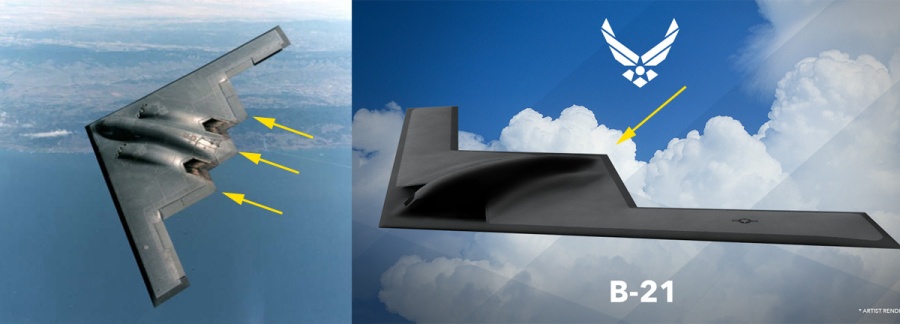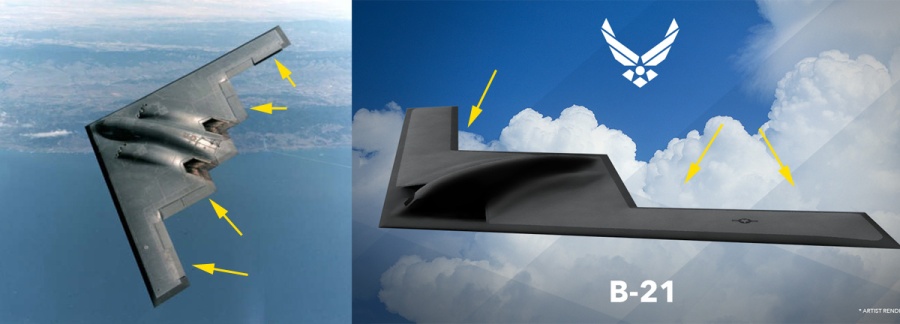The Air Force revealed today the first rendering of its new long range bomber: the B21. At first glance, it looks just like its last bomber, the B-2 Spirit – not so fast. Although this is only a rendering, and may not contain all the details the new aircraft will have, in this post I’ll compare the two and try to make some educated guesses as to what the differences may mean.
Difference #1: Engines

The first thing that struck me about the B-21 when compared to the B-2 are the engines. On the B-2, the engine nacelles are decidedly above the wings. They are very pronounced, with obvious intakes and exhausts. On the B-21, it appears that the engines are integral to the wing. The intakes are within the wing form and the exhausts… where are the exhausts? While there is only this one angle to gauge the new aircraft, there is no obvious engine output. I’m wondering if the output is spread along the trailing edge of the wing.
What it Means
Clearly, the reduced profile of the engines will present a smaller radar return. If indeed the exhaust is spread along a portion of the trailing edge of the wing, then it is possible that the heat signature is reduced.
Difference #2: Trailing Edge

The back end of the B-21 appears to be much cleaner than that of the B-2. A single point at the end of the fuselage replaces the three that bracket the engines on the B-2. If my assumption about an exhaust spreading feature is true, then it would explain the cleaner lines.
What it Means
I’m not sure that this design change is anything other than a design artifact from changing the engine exhaust. It’s possible that it presents a smaller radar return, but I have nothing to back up that thought.
Difference #3: Fuselage

It’s hard to say for sure, but it appears that the crew cabin and fuselage of the B-21 is sleeker overall. The angles where it intersects the wings appear to be smaller and the slopes more gradual.
What it Means
Smaller footprint and more gradual angles mean a lower radar return.
Difference #4: Control Surfaces

Okay, so I may be stretching it a bit here, but the rendering shows no control surfaces (flaps, ailerons). I will be the first to admit that it could just be a low fidelity 3D model, but if it isn’t, then the implications are staggering. It would mean that some form of vectored thrust is what pitches and rolls the aircraft. Again, I think it’s more likely that the surfaces are just not shown in the rendering, but if that’s not the case… wow.
What it Means
The only reason I could see for doing this would be to further reduce the radar return.
Summary
The B-21 seemingly has a number of upgrades that will lower its profile and could make the aircraft even stealthier than its predecessor. This is impressive considering how sleek the B-2 already is. I’ve had the pleasure of watching a significant amount of B2 flight time. During a couple of Space Shuttle missions, when I was on the recovery crew at Edwards Air Force Base in California, the B-2 was undergoing testing, and I was able to just sit and watch it fly. It was awe inspiring to see this massive, falcon-shaped aircraft banking through the air, only to all but disappear when it turned edge-on. It will be very interesting to see what, if any, of the differences I surmise in this post will actually come to fruition – only time will tell.
Image Credits: Air Force and Northrup Grumman

There is one other option for the control surfaces which would be mind warping if true. Yes, follow the pun and a return to the Wright Brothers wing warping ideas of their flyer.
3 years since this was first posted. Do we have any updates on the B-21 design???
Based on your comment, I did a quick write up. The short answer is no, but they are making progress.
[…] just got a friendly comment on my post about the new B-21 “Raider” stealth bomber. That post is a few years old and the person was asking for an update. Actually, I need to be doing […]
The comment in regards to the control surfaces of the B-21R, is not far off. The British (BAE Systems) designed a drone (DEMON) that uses compressed air from the APU in the form of thrust vectoring.